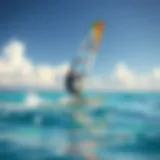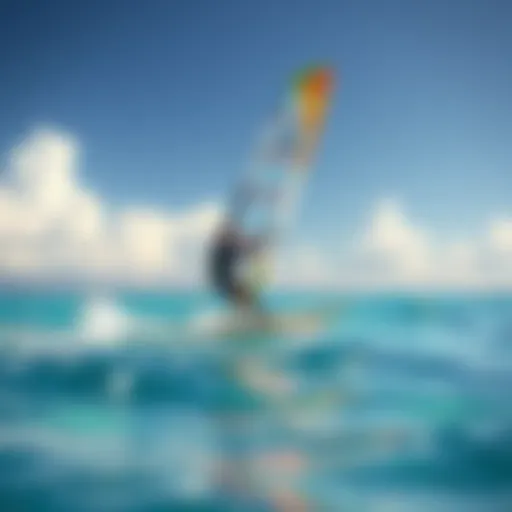San Francisco Wind Forecast for Kiteboarding


Intro
Kiteboarding in San Francisco offers an exhilarating experience, but it’s vital for riders to be clued-in on the winds that define this spectacular sport. The winds in this region can be as unpredictable as they are powerful, making a grasp of wind forecasts crucial for both novice and seasoned kiteboarders. Understanding how to interpret these forecasts effectively not only enhances safety but also maximizes the excitement of each session on the water.
In this guide, we will cover a variety of topics that kiteboarders must consider to make informed decisions. Specifically, we will highlight the importance of local geography on wind patterns, tips for timing your outings with wind conditions, and insights into the tools available for accurate forecasting. Prepare to dive into a detailed yet approachable exploration of the San Francisco wind scene, and equip yourself for a better kiteboarding experience.
Gear and Equipment
Getting the right gear is half the battle when it comes to kiteboarding, especially in an area with the unique wind dynamics like San Francisco.
Essential Kiteboarding Gear for Beginners
For newcomers, investing in the right equipment is crucial. Here are some must-have items:
- Kite: Choose a beginner-friendly kite that has a larger surface area for easier lift and stability. Brands like Naish and Cabrinha have excellent models suited for newcomers.
- Harness: A comfortable harness is essential for connecting the kite to your body. Opt for one that fits snugly but allows for movement.
- Board: A wider board offers better buoyancy, making it easier to ride. Look into models designed specifically for learning.
- Safety leash: This is your lifeline – always ensure it’s attached properly. It detaches your kite from you in case of a fall or emergency.
Advanced Equipment for Experienced Riders
Once you have a few sessions under your belt, you might want to upgrade your setup. Here’s what to consider:
- Performance Kites: These are smaller and designed for speed and maneuverability, perfect for tricks and higher wind conditions.
- Twin-tip Boards: Ideal for advanced riders, these boards offer versatility whether you’re riding regular or switch.
- Foil Boards: If you’re looking to glide over water with finesse rather than powered hops, foil boards could be your next step up.
Investing in quality gear tailored to your skill level can significantly enhance your kiteboarding experience.
Techniques and Tips
The thrill of kiteboarding comes with its own set of techniques and safety considerations that every rider should be aware of.
Safety Practices for Kiteboarding
Safety should always be a priority. Here are some crucial tips to keep in mind:
- Understand Your Equipment: Know how each piece of your setup works, especially the safety features.
- Check Weather Conditions: Pay attention to local forecasts and understand how wind patterns might change throughout the day.
- Avoid Crowded Areas: Kiteboarding can attract many enthusiasts. Make sure you have ample space to ride without endangering yourself or others.
- Always Wear a Life Vest: This can be a lifesaver in unforeseen situations. It keeps you buoyant and increases visibility for others.
Training Techniques to Improve Your Skills
Enhancing your kiteboarding skills takes time and practice. Here are some effective training tips:
- Practice in Controlled Environments: Start in areas where the winds are consistent and manageable before venturing into more challenging conditions.
- Build Core Strength: Incorporating strength training focusing on your core will improve your stability and control while riding.
- Join a Kiteboarding Class: Learning from professionals can provide invaluable insights and techniques that self-teaching might overlook.
Adopting these practices will not only make you a more confident rider but will also expand your capabilities on the water.
"The winds of San Francisco can turn on a dime, don’t let them take you by surprise. Knowledge is your best ally in kiteboarding."
By keeping safety in mind and continuing to refine your techniques, kiteboarding in San Francisco can be an unforgettable adventure.
The Significance of Wind in Kiteboarding
Kiteboarding thrives on the winds that empower it. Without the right wind conditions, what’s supposed to be an exhilarating experience can easily turn into a frustrating day spent on the shore. Understanding wind dynamics is not just useful; it’s paramount.
The essence of kiteboarding hinges on the wind’s strength, direction, and consistency. By grasping these elements, enthusiasts can elevate their performance significantly. Take, for instance, a clear blue sky on a sunny day. Without the breeze whispering through the air, that day would be far less enjoyable.
The Role of Wind in Kiteboarding Performance
Wind acts as both friend and foe. On one side, when conditions are ideal—steady and reliable winds—riders can harness power efficiently. This not only enhances jump heights and speeds but also elevates trick execution smoothness. Imagine attempting a fine jump with a gusty, unpredictable wind; it’s a recipe for disaster. Reliable winds give riders the confidence to push their limits, knowing the kite will respond predictably.
Conversely, adverse wind conditions can lead to serious safety issues and unplanned spills. Thus, understanding how wind influences technique helps kiteboarders not just perform better but also stay safe on the water.
Key Points to Consider:
- Consistency: Steady winds allow for a smooth experience.
- Strength: Determining the appropriate kite size in relation to wind strength is crucial.
- Control: Learning to control the kite in various wind conditions leads to improved skills.
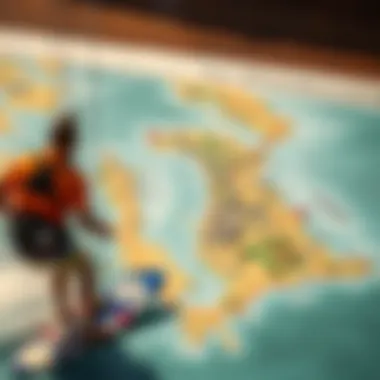
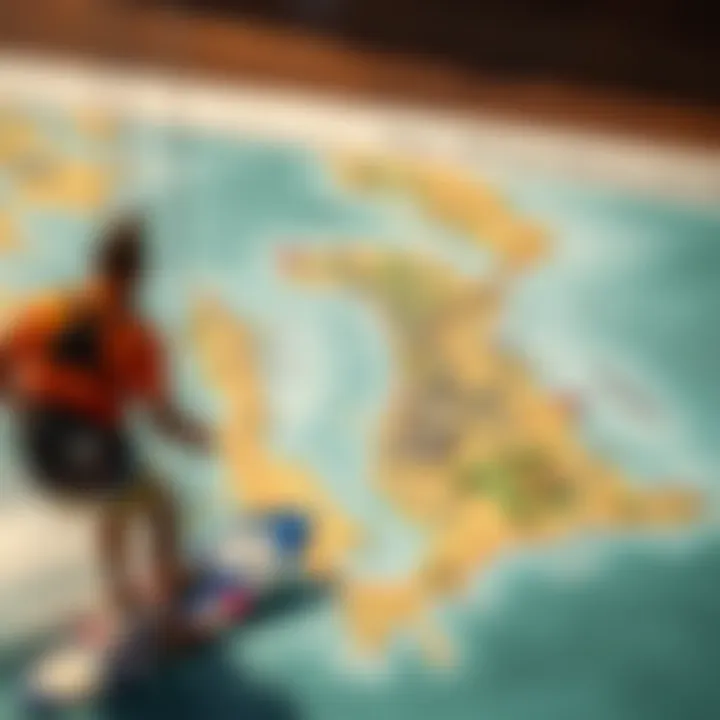
Understanding Wind Directions
A kiteboarder must be like a sailor who knows the wind’s every nuance. Wind direction plays a pivotal role, affecting everything from take-off to landing.
- Onshore Winds: These winds blow from the sea towards the land. They can provide gentle ridings, perfect for beginners wanting to practice skills away from rough conditions.
- Offshore Winds: These come from land to sea, often seen as more challenging. Riders must be cautious with these winds as they can push them farther away from the shore, potentially leading to dangerous situations.
- Crossshore Winds: These winds blow parallel to the shoreline, offering stable conditions that can be favorable for both beginners and advanced riders alike.
In essence, knowing how to read wind directions empowers kiteboarders. Noting local landmarks or consulting maps can make all the difference in anticipating wind behavior.
"Understanding the wind isn’t just about seeing arrows on a chart; it’s the essence of kiteboarding passion."
The significance of wind in kiteboarding is monumental. It drives performance and safety, helping kiteboarders make smart decisions that enhance their experience. Just as sailors have their compass, kiteboarders have the wind, and knowing how to navigate it can profoundly impact their time on the water.
Wind Patterns in San Francisco
Understanding wind patterns in San Francisco is crucial for kiteboarding enthusiasts. The ever-changing winds can either make or break a session on the water. Kiteboarders need to be well-versed in how these patterns operate because they are affected by various geographic and meteorological factors.
The wind isn't just a side character in the kiteboarding story; it's the lead role. A kiteboarder's performance hinges on the wind's strength and direction. Knowledge of local wind patterns can lead to better planning and, ultimately, more enjoyable and safe experiences on the water.
Geographic Influences on Wind
San Francisco's unique geography plays a fundamental role in shaping its wind patterns. The city is flanked by the Pacific Ocean on one side and the San Francisco Bay on the other. This positioning creates a dynamic interplay between sea breezes and land heat, a scenario that can result in varying wind speeds and directions throughout the day.
In simple terms, when the land heats up during the day, air above it rises, creating a low-pressure area. Cooler, denser air from the sea rushes in to fill this void, producing that all-important wind! The famous Golden Gate Bridge acts as a funnel for these winds, concentrating them as they flow inland. While this phenomenon is wonderful for kiteboarding, it’s essential to recognize that local obstructions—like hills and buildings—can alter these flows and create unpredictable gusts.
Understanding these geographic influences allows kiteboarders not only to choose the best times for their activities but also to anticipate changes in conditions that may arise due to shifting weather patterns.
Microclimates and Local Variations
San Francisco is renowned for its microclimates. What does that mean? Essentially, the everyday weather can be vastly different just a couple of miles apart. For kiteboarders, one key takeaway is that wind conditions at one spot might not be the same as at another.
For instance, the wind may be howling at Crissy Field but barely breezy at Ocean Beach. This variation is due to the city's geography and urban layout. Areas shielded by hills or buildings may experience less wind, while others that are open to the Bay can have strong gusts, making them ideal for kiteboarding.
Being familiar with these microclimates helps you decide where to ride based on not just the overall forecast but localized conditions. It can also guide you on how to adjust your equipment depending on the wind strength in each area. A savvy kiteboarder knows these nuances and looks to adapt rather than just react.
Remember: "Good wind is the kiteboarder's best friend, but understanding where to find it is just as critical."
In summary, the patterns of wind in San Francisco hold various nuances shaped by geographic features and local climate variations. Kiteboarders who pay attention to these details can enhance their on-water experiences, whether they are chasing thrills or simply enjoying a day under the sun.
How to Read Wind Forecasts
Kiteboarding enthusiasts often find themselves at the mercy of the wind. Hence, understanding how to read wind forecasts is crucial. Navigating this territory not only optimizes your experience but can also drastically impact your safety. The right wind conditions can make a good day great, while misleading forecasts can lead to discomfort or even danger.
Reading a wind forecast doesn’t have to be like deciphering hieroglyphics. It boils down to two primary aspects—the key metrics provided and the underlying forecast models. Here’s what you need to know.
Key Metrics in Wind Forecasts
When diving into wind forecasts, several key metrics stand out, and each carries its own importance:
- Wind Speed: This is usually measured in knots or miles per hour. A general rule of thumb for kiteboarding is that you want at least 12 knots (or about 14 mph) to get some serious action. Too little, and your kite might just sit there; too much, and you could be in for a rough ride.
- Wind Direction: This denotes where the wind is coming from, which is pivotal for kiteboarding. Different spots require different wind directions to be optimal. For instance, alongside the coastline, a wind blowing directly onshore might lift your kite but could also have gusts that increase in intensity unexpectedly.
- Gust Factor: This indicates fluctuations in wind speed. A gusty day can be both exhilarating and alarming. Understanding how often winds are gusting can help you gauge the conditions better.
- Sustained Wind: This reflects the average wind speed over a period. It’s this number that’s typically reliable when planning your outing; if it drops significantly from what you expect, it might be time to reevaluate.
These metrics can often be displayed in graphs or tables, making them relatively simple to grasp once you familiarize yourself with the layout.
Understanding Forecast Models
Forecast models can often read like a foreign language, yet they serve a foundational purpose in kiteboarding. The weather is fluid (pun intended), and so are the models predicting it. Here’s where you want to hone in:
- Numerical Weather Models: These models are based on physics and mathematics. They calculate weather changes by modeling the atmosphere using equations. This is usually where you get your wind speed and direction predictions. The Global Forecast System (GFS) model is a prime example, frequently used for kiteboarding forecasts.
- High-Resolution Models: These models provide a more detailed view of your local area’s wind conditions. They take elevation and other local features into account. One such model you might consider is the Rapid Refresh (RAP) model, which offers short-term updates and can be handy when you’re gearing up to hit the water.
Both types have their merits, and it’s worth keeping an eye on numerous forecasts to get a comprehensive picture. Remember, though, forecasts are not set in stone—conditions can change faster than you can say "kite!"
Understanding wind forecasts gives you a leg-up over the competition—be prepared to seize the day when conditions are right.
Tools for Accessing Wind Forecasts
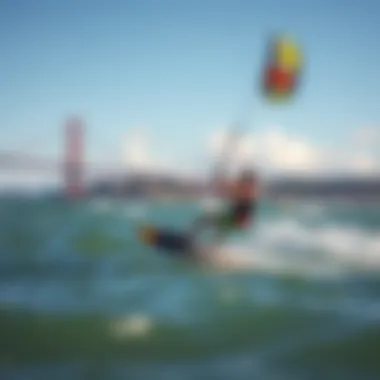
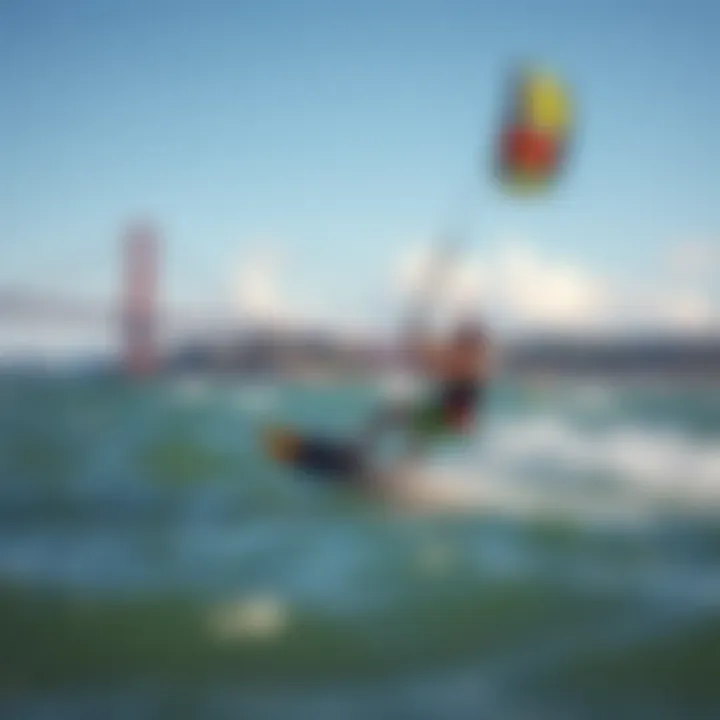
In the arena of kiteboarding, knowledge is as invaluable as the gear used on the water. Understanding the wind—its direction, speed, and patterns—can be the determining factor between an exhilarating session and a frustrating day on the beach. Utilizing the right tools for accessing wind forecasts is paramount for kiteboarding enthusiasts who wish to ride the waves at their best. In this section, we’ll break down the options available, clarifying their benefits and considerations that kiteboarders should keep in mind.
Online Forecasting Platforms
When it comes to wind forecasting, online platforms have become the bread and butter for kiteboarding aficionados. They offer a broad range of features tailored specifically for water sports, including real-time updates, historical data, and detailed meteorological analysis. While each platform may differ slightly, here are some key aspects worth considering:
- User-Friendly Interfaces: Many forecasting sites are designed with ease of use in mind. Kiteboarders can quickly grasp the important metrics without feeling overwhelmed.
- Real-Time Data: Wind conditions can change in the blink of an eye. Access to real-time data means kiteboarders can decide last minute whether it’s a go or no-go.
- Community Inputs: Certain platforms benefit from input from local riders, providing firsthand accounts of conditions that numerical data might not fully capture.
Some popular sites include:
- Windfinder: This site provides wind and weather forecasts specifically for kiteboarding, featuring various locations including beaches and bays.
- Meteoblue: Renowned for its detailed and accurate forecasts, Meteoblue combines satellite data with user data for enhanced reliability.
- AWEKAS: An interactive weather portal that boasts a network of livedata, making it a favorite among experienced kiteboarders.
Make sure to compare different platforms to find the one that resonates best with your kiteboarding needs.
Mobile Applications for Kiteboarding
In a world that’s as fast-paced as kiteboarding, having a trusty mobile app is akin to possessing an ace up your sleeve. The beauty of mobile applications is their ability to provide portable, on-the-go updates, meaning that kiteboarders can stay in the loop while out and about. The benefit of these apps goes beyond just forecasts. Consider the following features:
- Push Notifications: Many apps offer alerts about changing wind conditions, allowing kiteboarders to adjust plans without needing to check forecasts constantly.
- Offline Access: Some applications store essential data to be accessed even when a signal is weak—crucial for those remote surfing locations.
- Localized Forecasts: Certain applications hone in on your specific location, making them more accurate than generalized websites.
Here are a few mobile apps worth downloading:
- Kite Map: This app enables users to locate kiteboarding spots while also delivering weather updates and forecasts specific to those locations.
- Windy: Highly rated for its intuitive design, Windy offers extensive weather maps, radar data, and a community forum for sharing conditions.
- Magicseaweed: Although initially a surf app, it provides excellent wind data and can be extremely useful for kiteboarders too.
Stay informed and be prepared. Using the right tools opens doors to a phenomenal kiteboarding experience, ensuring you harness nature’s resources at the right place and time.
Seasonal Wind Trends in San Francisco
Understanding the seasonal wind trends in San Francisco is crucial for kiteboarding enthusiasts who rely on these conditions for optimal performance and safety. The nature of winds here changes considerably with the seasons, and recognizing these patterns can mean the difference between an exhilarating session and an unexpectedly rough ride.
Summer Wind Patterns
During the summer months, one notable feature of San Francisco's wind is the consistent trade winds that sweep down from the northwest. These winds tend to be steady and reliable, peaking in strength typically in the afternoon. Kiteboarders can expect the winds to range from 15 to 25 knots, creating the perfect conditions for both novices and seasoned kiteboarders alike.
The geographical layout of the coastline plays a vital role during this season. The open sea and the unique topography contribute to wind channels, funneling gusts and enhancing the overall wind experience. Places like Crissy Field become hotspots, attracting kiteboarders eager to take advantage of these summer conditions.
In the summer, it’s also essential to keep an eye on local microclimates. Even slight changes in temperature can affect wind conditions dramatically. Beginners should pay attention to local weather forecasts, as winds can vary from one location to another within close proximity.
"A thorough understanding of summer wind patterns is like having a golden ticket in kiteboarding. Knowledge is power!"
Winter Conditions and Challenges
Winter in San Francisco brings a different scenario altogether. Kiteboarders face a mixed bag of wind conditions, highlighted by sporadic storms and irregular wind patterns. During the cold months, winds often come from various directions and can sometimes be gusty and unpredictable, creating challenges that require sharp skills.
Wind speeds can be more variable, and it's not uncommon to experience shifts from light breezes to fierce gusts in a matter of minutes. As such, kiteboarders must be vigilant and prepared to adapt quickly. Familiar hotspots like Fort Point may not offer the same reliability as in summer, prompting enthusiasts to scout new locations or adjust their kites accordingly.
Additionally, winter waters can be choppier, which adds another layer of complexity. Safety becomes paramount, and kiteboarders must ensure they have the right gear for cooler conditions and potential hazards. Those experienced in the winter kiteboarding scene often emphasize the significance of understanding the weather forecasts and local reports in order to stay safe.
Best Kiteboarding Spots in San Francisco
Kiteboarding in San Francisco is an exhilarating experience, one that is deeply influenced by the region’s unique wind conditions and picturesque landscapes. Knowing where to go can make all the difference between a rather ‘meh’ session and an adrenaline-pumping ride. The significance of understanding the best kiteboarding spots can’t be understated. When the wind decides to turn in your favor, being in the right location allows you to harness its power while enjoying stunning views of the city and beyond. This section will explore popular kiteboarding locations and reveal hidden gems that can elevate your kiteboarding adventure, whether you are a seasoned pro or a beginner eager to soar.
Analysis of Popular Locations
When it comes to popular kiteboarding spots in San Francisco, a few locations stand out, drawing enthusiasts from near and far.
- Crissy Field: Often the crown jewel for kiteboarders, Crissy Field boasts consistent thermal winds and stunning views of the Golden Gate Bridge. It’s a popular training ground, especially for those new to the sport. The sandy launch areas and ample space to ride make it a go-to for many. However, it can get crowded, especially on warm weekends.
- Ocean Beach: If you’re feeling bold, Ocean Beach may just be the spot for you. Known for its powerful waves and strong currents, this location demands respect. Only for the more experienced riders, Ocean Beach’s conditions can change rapidly, offering a thrilling challenge for those who dare.
- Treasure Island: A bit more off the beaten path, Treasure Island combines spectacular views of the San Francisco skyline with a consistent wind pattern. It’s not as crowded, and the space makes it a great choice for those looking to practice without the hullabaloo of larger beaches. Plus, the sunsets here are nothing short of spectacular, providing a perfect backdrop after a long day on the water.
"Location can elevate your experience from ordinary to spectacular, especially when the wind is just right."
Hidden Gems for Advanced Riders
Now, let’s pivot to some hidden gems that tend to fly under the radar but are perfect for advanced riders willing to seek out lesser-known kiteboarding spots.
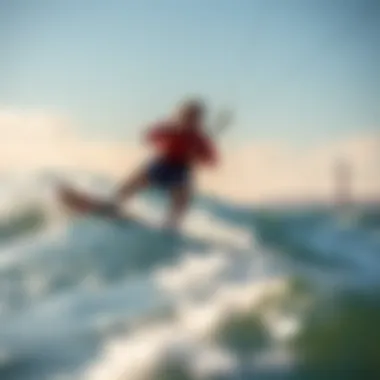
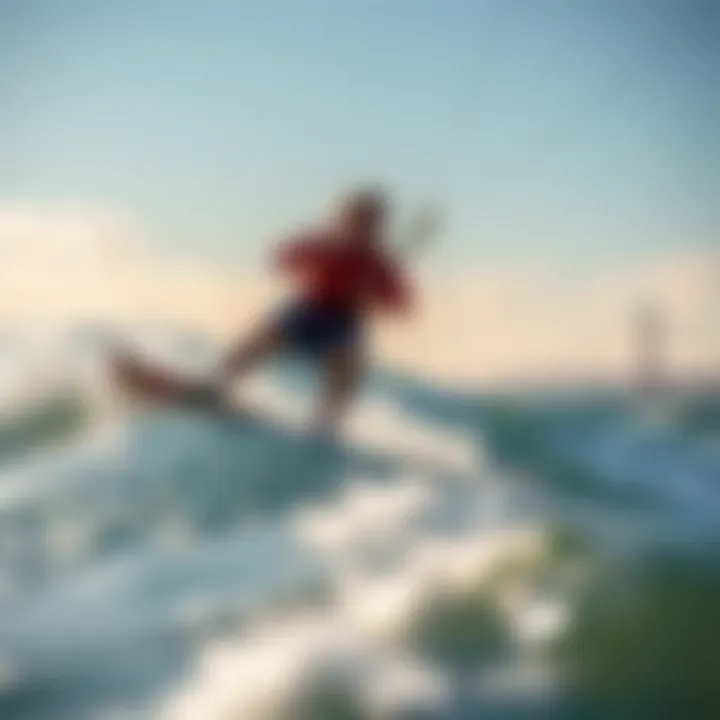
- China Camp State Park: Nestled in Marin County, this area offers a serene level of isolation with great wind. The distinctive thermal winds here can be exhilarating on the right day, and when it’s on, you’ll experience the thrill of carving through waters less traveled. The natural beauty of the park itself is just an added bonus.
- Marin Headlands: If you want some varied terrain paired with strong winds, the Marin Headlands offers some hidden coves and beaches where kiteboarders can escape the mainstream crowd. Be prepared, though, as the conditions can shift quickly.
- Half Moon Bay: A bit farther out, but worth the drive, Half Moon Bay features a stretch of beach where savvy kiteboarders often find themselves enjoying stunning conditions, especially during the spring and fall. The coastal winds here can be quite favorable and help to create challenging yet enjoyable riding opportunities.
Safety Considerations Related to Wind Conditions
Understanding the wind conditions is crucial for kiteboarders not only to enhance their performance but to ensure their safety. The ocean can be a beautiful yet unpredictable expanse; factors such as sudden gusts, changing wind directions, and the strength of the wind can turn an enjoyable day into a hazardous one. Therefore, maintaining a keen awareness of these elements becomes an essential aspect of kiteboarding in San Francisco.
Before hitting the water, kiteboarders should closely monitor the wind forecast and familiarize themselves with the specific conditions of their chosen spots. This not only includes knowing the typical wind patterns but also highlights the need for ongoing vigilance once out on the water. Safety precautions can make the difference between a thrilling adventure and an unfortunate mishap.
Remember: Safety isn't just a good habit; it's a kiteboarder's lifeline.
Identifying Unsafe Wind Conditions
Several factors can flag dangerous wind conditions. Here are some key signs to look out for:
- Constantly Shifting Winds: When the wind changes direction frequently, it can make controlling the kite difficult.
- Gusty Conditions: If wind speeds fluctuate wildly, especially exceeding the comfort zone for your skill level or equipment, it could indicate potential danger.
- Heavy Swell and Choppy Water: Rough waters can amplify the challenges of wind, making navigation tricky and increasing the risk for falls and crashes.
Monitoring local reports and using devices like an anemometer can help gauge wind speeds directly, allowing for an immediate understanding of varying conditions. If you find yourself questioning whether it’s safe, it’s often better to err on the side of caution and delay your session.
Emergency Procedures During Extreme Weather
In the unfortunate event that conditions take a turn for the worse, being prepared with a solid emergency plan can be crucial. Here are steps to follow:
- Know Your Exit Route: Familiarize yourself with the nearest points of land and safe zones before you head out.
- Use a Quick Release Mechanism: Ensure your kite has a reliable quick-release feature so that you can detach from it swiftly if necessary.
- Stay with Your Board: In high winds, your board can serve as a flotation device, helping to keep you afloat until help arrives.
- Signal for Help: If you’re in distress, use your arms to signal your need for assistance. Ensure someone on shore is aware of your location and plans to watch you during your kite session.
Being aware of these safety measures will not only boost your confidence on the water but also contributes to a safer kiteboarding culture overall. Encouraging your fellow kiteboarders to respect and adhere to safety measures can cultivate a communal atmosphere of care and caution, ultimately benefiting everyone.
Advice from Experienced Kiteboarders
Navigating the winds when kiteboarding is both an art and a science. The guidance from those who've spent countless hours harnessing the elements can offer invaluable insights. Experienced kiteboarders understand that each ride can be unpredictable, shifting like the tides. Their advice serves not just to improve your skills but to elevate your safety and enjoyment on the water.
Tips for Anticipating Wind Changes
One of the core skills that separates an amateur from an adept kiteboarder is the ability to anticipate wind changes. Here are some methods the veterans recommend:
- Observe the Environment: Take a close look at the surroundings. If you see flags waving in a different direction or trees bending, it’s a clue that shifts are brewing.
- Watch for Patters: Winds can change based on time of day. Afternoon breezes, for instance, often pick up as the land heats. Make it a habit to track these anomalies.
- Sense the Air: The feeling of the wind on your face can be a telling sign. If the breeze feels lighter or shifts direction, it might be time to adjust your kite position or even consider landing.
- Check Local Reports: The weather can be fickle. Wind forecasts are not always entirely accurate, especially in San Francisco features unique microclimates. Relying on local reports can give you a more nuanced understanding than broader forecasts.
"Every kiteboarder should learn to read the wind like an open book – the more you understand, the better you ride," says seasoned rider Jamie Quant.
Personal Wind Forecasting Techniques
To improve your kiteboarding experience, some experienced kiteboarders turn to personal wind forecasting techniques that go beyond just checking the weather app. Here’s what some of them impart:
- Journaling Your Sessions: Keeping a log of your kiteboarding sessions, including wind speeds, directions, and how your kite performed, can create a historical reference that’s tailored to you.
- Engaging with the Community: Chat with fellow kiteboarders, especially those who frequent the same spots. They often have their ear to the ground regarding local wind conditions and can provide real-time insights.
- Using Technology: Integrating smartphone apps like Windy or KPL (Kiteboarding Life) can improve your forecasting. These platforms often provide more localized wind info that might not be apparent on regular weather sites.
- Practice, Practice, Practice: The more you kite, the more you’ll begin to notice patterns and cues in the wind. Each session will teach you something new, helping you refine your instincts over time.
By applying these insights and tips from seasoned kiteboarders, you stand not only to enhance your skills but also to develop a deeper connection with the winds that power your passion.
The End: Maximizing Your Kiteboarding Experience
In the world of kiteboarding, mastering the art of wind prediction can mean the difference between an exhilarating day on the water and a frustrating encounter with unfavorable conditions. The key takeaway here is that understanding the wind forecast not only enhances your performance but also enriches your enjoyment of the sport. This section ties together all the insights provided in previous sections, emphasizing how to apply them in practical ways to get the most out of your kiteboarding experience.
Aligning Skills with Wind Conditions
When it comes to kiteboarding, aligning your skills with wind conditions is absolutely paramount. Every kiteboarder, from beginner to advanced, has a unique skill set that can either match or clash with varying wind dynamics. For instance:
- Light winds (less than 10 knots) might suit newer riders who are still learning the ropes, allowing them to experiment with balance and control.
- Moderate winds (10-20 knots) often provide the sweet spot for most intermediate kiteboarders, enabling playful tricks and fluid transitions.
- Strong winds (above 20 knots) can be exhilarating but require substantial skill and confidence. Advanced riders usually thrive in these conditions, executing jumps and complex maneuvers with finesse.
Keeping a close eye on shifting wind patterns gives kiteboarders a chance to fine-tune their equipment choice. For example, selecting the right size kite based on wind conditions is critical. Minimizing your risk of hardware mishaps or risky rides can lead to fewer accidents and more enjoyable days out on the water.
Continued Learning and Adaptation
In sports, just like in life, stagnation equals regression. Kiteboarding offers a great example of how one can continue learning even after mastering basic techniques. The dynamic nature of wind conditions requires kiteboarders to stay adaptive and informed.
Regularly reviewing your wind forecasting habits can create a culture of continuous learning.
- Participate in workshops to refine your skills further.
- Engage with local kiteboarding communities, possibly through platforms like Reddit or social media groups, to learn from others’ experiences.
- Explore reputable forecasting websites or apps to stay updated on the best practices for interpreting the data.
"The ocean is a classroom, and the wind is your teacher - never stop asking questions."
Embracing adaptability not only prepares you for unexpected changes, but also fosters your growth as an athlete. The wind will always shift, and the best kiteboarders are the ones who change course seamlessly with it.
